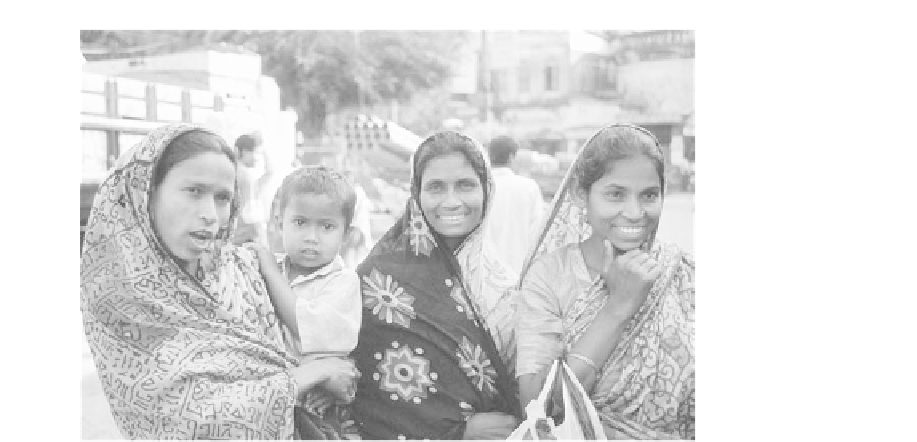Geography Reference
In-Depth Information
Figure 9-7
Bangladeshi women. Self-help programs are
improving the lives of many women in Bangladesh.
These women are middle class.
Photo courtesy of
B. A. Weightman
.
and craft and other cooperatives have markedly advanced
living standards for some Bangladeshi women.
Bangladesh' s population dilemmas derive more from
distribution than from sheer numbers. Rural-to-urban mi-
gration has overwhelmed cities, especially Dhaka and
Chittagong. In 1961, a mere 5 percent of Bangladeshis lived
in cities. In 1991 it was 18 percent. Currently , 25 percent
live in urban places, and by 2015 that will increase to
37percent. In other words, 80 million Bangladeshis will
be urban residents by 2020. This is an amazing number in
the context of infrastructural requirements.
Take power availability as an example. Only 16 per-
cent of Bangladeshis have access to electricity . The coun-
try often faces riots over blackouts. At the opening of the
largest generating plant, 30 miles (50 km) northwest of
Dhaka, Prime Minister Sheikh Hasina urged people to
save electricity at home and at work by shutting off
lights. Public and private sector projects were expected
to boost the national grid' s power to 4,700 megawatts by
2002. But there is another problem: People tap into power
lines illegally , and nearly 30 percent of power production
is lost to theft.
Poor migrants typically end up living in slums, squatter
settlements, or as pavement dwellers. There are already
about 25 million of these individuals, more males than
females.
Dhaka, the country' s capital and primate city , attracts
the most migrants. In 1992, Dhaka had 7.4 million in-
habitants. It now has 10 million. By 2015, it is expected
to have 17 million residents, with at least 50 percent
living in slums or worse. Dhaka' s Old City can only be
described as a hive of humanity (Figure 9-8).
Every crumbling building, room, cubicle, alley ,
doorway , and indentation reveals people living in every
imaginable condition. The narrow streets are crammed
with people, carts, bicycle rickshaws, trucks, and buses,
all carrying stupendous loads of oil drums, cotton bales,
vegetables, sacks of ice, sheets of metal, thousands of
rubber thongs (flip-flops), and baskets of poultry . The
city is a limitless kaleidoscope of colors, sounds, and
smells.
Child labor is common. This is reflected in the fact
that only 20 percent of slum children attend school. In
addition, at least one-third of slum dwellers are sick at
any one time. Slum communities have the highest infant
and maternal mortality rates in the nation, in part
because health-care programs have been geared to rural
as well as more affluent urban areas.
Outside Dhaka' s Old City are still relatively old areas
that are becoming increasingly densified. Here, unchecked
settlement outpaces government efforts to develop housing
and other infrastructural needs. Incentives to decentralize
and create communities outside the city have met with
limited success.
Dilemmas of Growth
CONDITIONS IN THE CITIES
Rural push factors drive urban migration streams while
growth in production is not expected to meet employ-
ment needs. As population experts Professor Abdul
Barkat, U. R. Mati, and M. L. Bose (1997) point out, “ur-
banization in Bangladesh will remain poverty-driven.”

















Search WWH ::

Custom Search